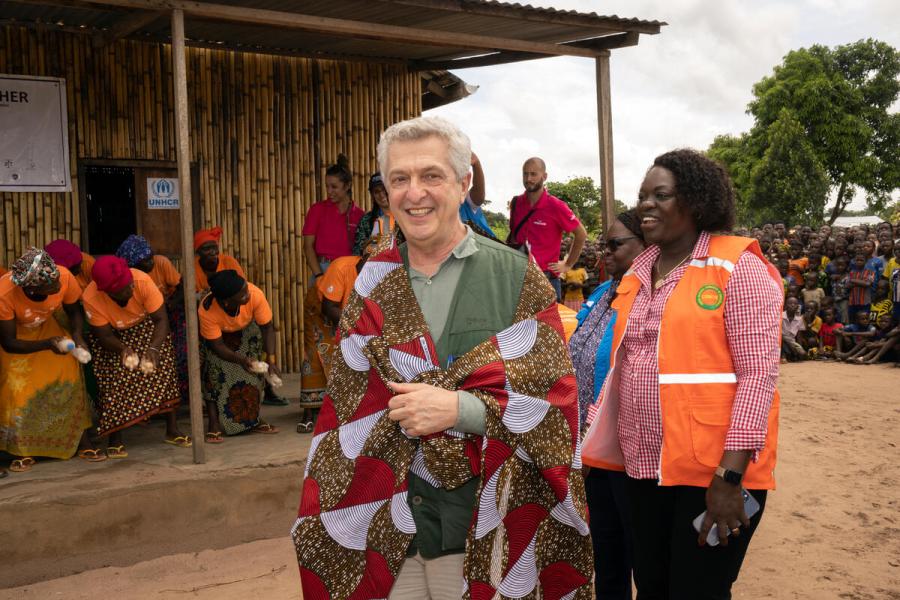Since 2017, Mozambique has been immersed in a humanitarian crisis linked to violence perpetrated by non-state armed groups that deeply impacts the 25,000 refugees and asylum-seekers hosted by the country and which has led to the internal displacement of 850,500 people. In addition to these challenges, Mozambique, one of the countries most adversely affected by the impacts of the climate crisis in the world, also struggled with more than 40,000 people internally displaced by extreme weather events as of December 2023. The double landfall of Tropical Cyclone Freddy in February and March 2023, a year following the devastation brought by Tropical Cyclone Gombe, for instance, affected over 1 million people, destroyed infrastructure, and displaced some 184,000 people. Throughout 2023, 300,966 people returned to their areas of origin, many of which still lack basic services and adequate living conditions. UNHCR continues to stress that all return movements should occur in an informed, safe, voluntary, and dignified manner.
UNHCR Mozambique continues to work with authorities and development actors to address the protection and assistance needs and support sustainable solutions for internally displaced people in the northern provinces of Cabo Delgado, Nampula, and Niassa, for refugees and asylum-seekers, and for the communities that host them. In addition, preparedness and response efforts to natural hazards, including cyclones, flooding, and drought, are also cross-cutting in the response.
Populations
Population types
Note: The "Stateless" category does not include stateless people who are also in other categories, to avoid double counting. The total number of stateless, across all categories, is .
NB: 2025 figures are planning figures.
Source: UNHCR Refugee Data Finder for years until 2022, UNHCR planning figures (COMPASS) otherwise.
Population by country
NB: 2025 figures are planning figures.
Source: UNHCR Refugee Data Finder for years until 2022, UNHCR planning figures (COMPASS) otherwise.
Population by origin
NB: 2025 figures are planning figures.
Source: UNHCR Refugee Data Finder for years until 2022, UNHCR planning figures (COMPASS) otherwise.
Financials
Budget and expenditure trend
Budget information for the current year is updated monthly, while budget and expenditure information for all other years are final.
Budget by pillar
Budget by objective
Note: The table presents the budget for this operation broken down at the objective level. Resource allocation at the objective level is subject to change during the course of the year as the operational situation evolves and priorities shift. The current budget, reflected in the bottom line of this table, is updated on a monthly basis and is replaced by the final budget at year-end.
Expenditure by Outcome Area
Budget by Impact Area
Source: 2023 budget as approved by the Executive Committee in October 2022.
2022 current budget as approved by the High Commissioner as of October 2022; pending presentation to the ExCom's Standing Committee.
Budget by Outcome and Enabling Areas
Source: 2023 budget as approved by the Executive Committee in October 2022.
2022 current budget as approved by the High Commissioner as of October 2022; pending presentation to the ExCom's Standing Committee.
Budget by Impact Area
Source: 2024 budget and 2023 current budget are taken from the budget document approved by UNHCR's Executive Committee in October 2023.
Budget by Impact Area
Budget information for the current year is updated monthly, while budget and expenditure information for all other years are final.
Budget by Outcome and Enabling Areas
Budget by Outcome and Enabling Areas
Budget information for the current year is updated monthly, while budget and expenditure information for all other years are final.
Budget by Impact Area
Budget by Outcome and Enabling Areas
Strategy
Impact Statements
Latest updates
The boundaries and names shown and the designations used on this map do not imply official endorsement or acceptance by the United Nations.
UNHCR GIS data is publicly accessible in the Operational Data Portal






